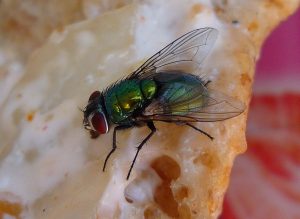Around the house, I’m known as the fly slayer, because in Brisbane at this time of year, we leave our balconies open.
 But I can’t stand flies in my kitchen.
But I can’t stand flies in my kitchen.
The mechanical transmission of pathogenic bacteria by synanthropic filth flies is widely recognized. While many studies report the fate and the temporospatial distribution of ingested foodborne bacteria by filth flies, there is little evidence about the transmission dynamics of ingested foodborne bacteria by adult house flies (Musca domestica) to their progeny.
In this study, we fed parental house fly adults with food contaminated with low, medium, and high concentrations of Salmonella enterica, Cronobacter sakazakii, Escherichia coli O157:H7, and Listeria monocytogenes and evaluated the probability of transmission of these pathogens to house fly eggs and the surface and the alimentary canal of their first filial (F 1 ) generation adults.
Results: All foodborne pathogens were present in samples containing pooled house fly eggs. The probability of transmission was higher after parental house flies ingested food containing medium bacterial loads.
Cronobacter sakazakii was 16, 6, and 3 times more likely to be transmitted to house fly eggs than S. enterica, E. coli O157:H7, and L. monocytogenes, respectively.
Only S. enterica and C. sakazakii were transmitted to F 1 generation adults and their presence was 2.4 times more likely on their body surfaces than in their alimentary canals. The highest probabilities of finding S. enterica (60Â %) and C. sakazakii (28Â %) on newly emerged F 1 adults were observed after parental house flies ingested food containing medium and high levels of these pathogens, respectively.
Conclusion: Our study demonstrates that adult house flies that fed from food contaminated with various levels of foodborne bacteria were able to transmit those pathogens to their eggs and some were further transmitted to newly emerged F 1 generation adults, enhancing the vector potential of these insects.
Understanding the type of associations that synanthropic filth flies establish with foodborne pathogens will help to elucidate transmission mechanisms and possible ways to mitigate the spread of foodborne pathogens.
Ingested Salmonella enterica, Cronobacter sakazakii, Escherichia coli O157:H7, and Listeria monocytogenes: transmission dynamics from adult house flies to their eggs and first filial (F 1 ) generation adults
7th Space Interactive, BMC Microbiology 2015
Monica Pava-Ripoll Rachel Pearson Amy Miller Ben Tall Christine Keys George Ziobro
http://7thspace.com/headlines/514122/ingested_salmonella_enterica_cronobacter_sakazakii_escherichia_coli_o157h7_and_listeria_monocytogenes_transmission_dynamics_from_adult_house_flies_to_their_eggs_and_first_filial_f___________________1_generation_adults.html
 Musca domestica L. HF (n = 3,440) were collected from two sites on a cattle farm over a 4-month period and processed individually for E. coli O157:H7 isolation and quantification. The prevalence of E. coli O157:H7 was 2.9 and 1.4% in HF collected from feed bunks and a cattle feed storage shed, respectively. E. coli O157:H7 counts ranged from 3.0 × 101 to 1.5 × 105 CFU among the positive HF. PCR analysis of the E. coli O157:H7 isolates revealed that 90.4, 99.2, 99.2, and 100% of them (n = 125) possessed the stx1, stx2, eaeA, and fliC genes, respectively.
Musca domestica L. HF (n = 3,440) were collected from two sites on a cattle farm over a 4-month period and processed individually for E. coli O157:H7 isolation and quantification. The prevalence of E. coli O157:H7 was 2.9 and 1.4% in HF collected from feed bunks and a cattle feed storage shed, respectively. E. coli O157:H7 counts ranged from 3.0 × 101 to 1.5 × 105 CFU among the positive HF. PCR analysis of the E. coli O157:H7 isolates revealed that 90.4, 99.2, 99.2, and 100% of them (n = 125) possessed the stx1, stx2, eaeA, and fliC genes, respectively.






 Monday as a "new standard for public toilet management," the Beijing News reported.
Monday as a "new standard for public toilet management," the Beijing News reported..jpg) damaged as a result of E. coli O157 after eating a veggie burger and chips from the Llay Fish Bar in 2009.
damaged as a result of E. coli O157 after eating a veggie burger and chips from the Llay Fish Bar in 2009..jpg) background reports. But in granting him bail, he told him that he should not interpret that as meaning there would not be a prison sentence.
background reports. But in granting him bail, he told him that he should not interpret that as meaning there would not be a prison sentence.